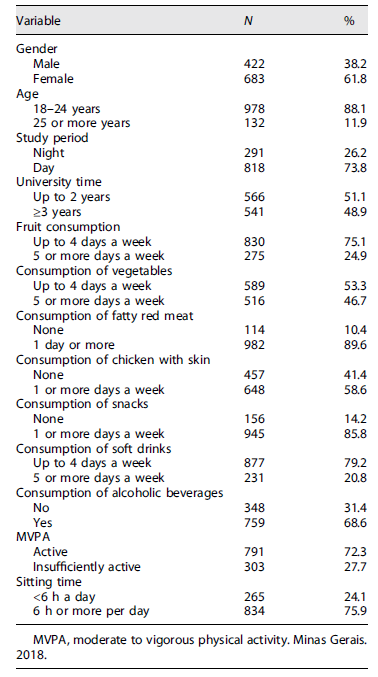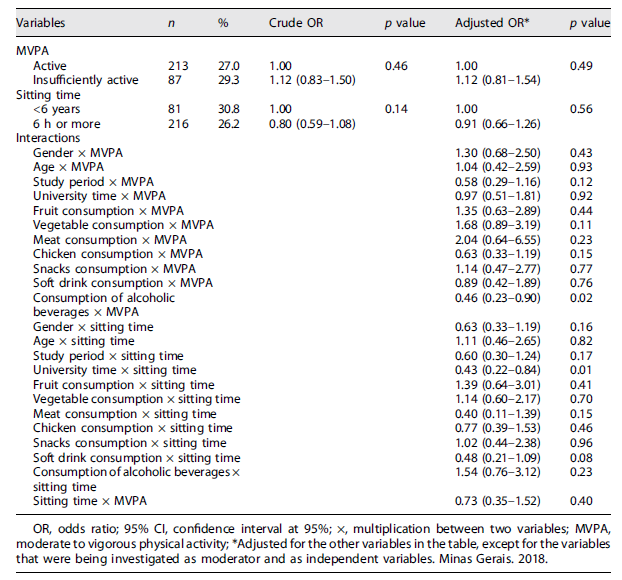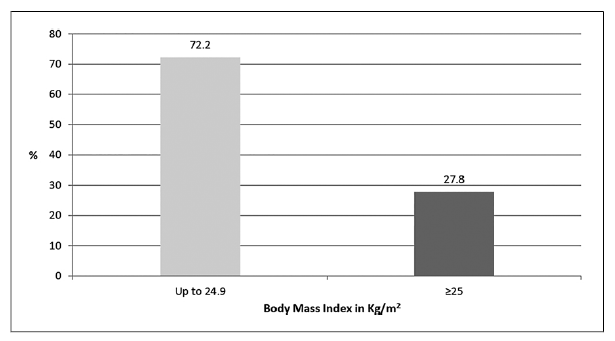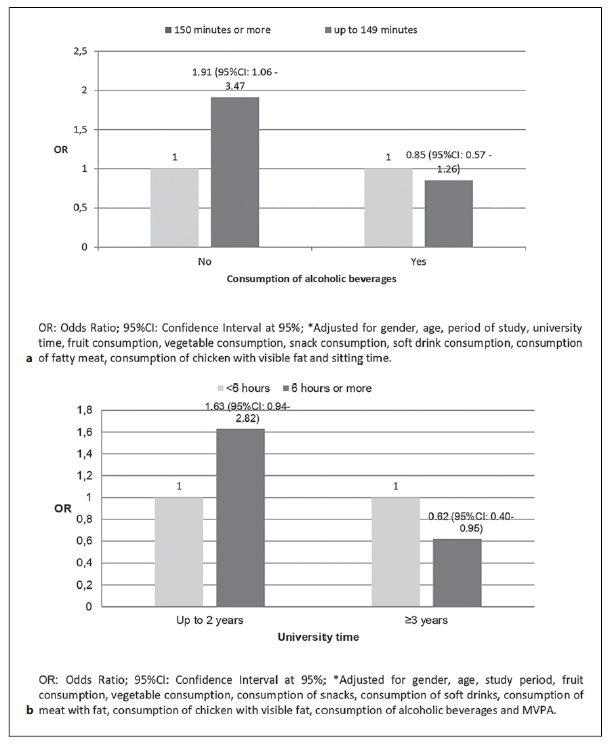Introduction
The health of university students represents a construct of interest to researchers 1, due to the adoption of behaviors that leave them exposed to chronic non-communicable diseases during their academic lives 1. These behaviors favor the risk of excess body weight (EBW), that is, overweight (body mass index (BMI): 25-29.9 kg/m2) and obesity (BMI: ≥30 kg/m2), both in men and women 2,3, and research points to increasing prevalence and/or incidence of EBW in university students 2,3.
Risk behaviors such as insufficient physical activity 1 and long time spent in sedentary behaviors 4 can be direct determinants in the development of EBW 1,4. Sedentary behavior is related to energy expenditure in activities that correspond to <1.5 metabolic equivalents in sitting, reclining, or lying positions 5; on the other hand, the minimum physical activity necessary to obtain benefits must be at least 150 min in moderate intensity or 75 min at a vigorous intensity or a combination of both intensities 6.
These behaviors at inappropriate levels, in addition to being directly associated with the EBW 3,4, may have their effects modified by other characteristics due to interactions that can maximize or minimize the occurrence of this outcome. This peculiarity is called the moderating effect due to a variable that affects the direction and/or strength of the relationship between the investigated characteristics 7. Studies have shown that the country where the participants live represented an important moderator of the association between physical activity and sedentary time in relation to EBW, as well as food business points modified the effect of the association between sedentary time and EBW in elderly people 8 and that the level of cardiorespiratory fitness showed interaction with physical activity in association with EBW in children and adolescents 9.
In view of the information in the literature that shows the impact of physical activity 3 and sedentary behavior 4 in relation to EBW, such as obesity in university students 10, it is essential to characterize the role of possible moderators in the association of physical activity and sitting time considering the health risk condition of EBW. Possibly sociodemographic factors, such as gender (male), the relationship with the university itself due to exposure to the academic experience, as well as dietary aspects, such as the consumption of alcoholic beverages 2,3,10, can moderate this relationship. The study of this topic is extremely relevant since at least 2.8 million deaths every year result from the EBW 11 and the information from this type of research may support the development of programs/projects at the university and institutional policies focused on EBW. Therefore, the objectives of this study were to estimate the prevalence of EBW and verify the direct association, considering sociodemographic, university, and behavioral moderating variables, between physical activity and sitting time related to EBW in Brazilian university students.
Materials and Methods
This cross-sectional study is part of the first survey of the study “Profile of Lifestyle and Quality of Life of Students at the Federal University of Triângulo Mineiro (UFTM),” carried out in 2018 at a public university in the state of Minas Gerais, Brazil. The research was approved by the Research Ethics Committee (CEP) of UFTM with protocol number: 2.402.734. The target population was university students enrolled in the first academic semester in presential undergraduate courses at UFTM, Uberaba-MG, during the day and night shifts.
For the sample size calculation 12, a target population of 5,952 university students, a prevalence of 50% due to a lack of knowledge of the outcomes, a confidence level of 95%, and an acceptable sampling error of three percentage points were considered. Finally, 20% were added for losses and another 10% for control of confounding factors in association studies, based on the study of repeated surveys with samples of Brazilian university students, who participated by simple random selection, and observed losses among 12% and 15% 13 and the research with adults 14, which used a sample increase of 15% to perform the multivariate analysis. Thus, in this study, an estimated sample of 1,195 university students was calculated.
As a way of standardizing the data collection, in March 2018, the training of the team composed of undergraduate and postgraduate students in Physical Education at UFTM was carried out. Subsequently, between the months of April and July of the same year, the process for data collection was carried out, by verifying the occurrence of classes and applying the instrument in a similar way to the volunteers, in small groups of up to 30 people or individually, on the university premises, thus ensuring a similar location but on different days of the week.
To ensure the proportional participation of university students, the sample was stratified according to the distribution of university students among the institution’s 25 courses. The participation process was for convenience. University students aged 18 years or older were included, regardless of gender and physical conditions. University students from distance learning courses, with special enrollment (students with a higher education diploma who enroll in undergraduate courses), technical courses and courses belonging to the Iturama Campus (Agronomy, Licentiate in Biological Sciences and Chemistry) were excluded. The Iturama Campus is linked to the UFTM, which was inaugurated on February 13, 2015, and, due to the little time of implantation and structure, it was excluded from the research. These exclusions occurred after tabulating the information. Such actions were possible due to the questions inserted in the instrument.
The information was obtained by self-completion of a questionnaire, with the supervision of a researcher. The instrument consisted of questions from the Academic Health and Quality of Life Indicators (ISAQ-A) 15 questionnaire, validated for Brazilian university students, and the International Physical Activity Questionnaire (IPAQ) 16, validated for research with young adults.
The dependent variable was BMI and the outcome was EBW (≥25 kg/m2), calculated using the aforementioned measurements of body mass and height using the standard equation of the World Health Organization 17. Height in meters and body mass in kilograms, both referred to, present satisfactory levels of reproducibility (by analyzing the Bland-Altman scatter plot, the mean difference being −0.002, 95% CI: −0.006 to 0.003, and mean difference 0.36, 95% CI: −0.19; 0.91), respectively 13 and have concurrent validity with acceptable levels of sensitivity and specificity 18 for studies with university students 15,18.
The independent variables were the practice of physical activities and sitting time, measured by the IPAQ 16. Moderate to vigorous physical activity (MVPA) per week was classified as up to 149 min (insufficiently active) and 150 min or more (active), according to the Physical Activity Guide for the Brazilian population 6. The minutes of vigorous-intensity practice were multiplied by two in the composition of the total time 14. The IPAQ measure of physical activity has satisfactory validity (Spearman correlation, rho = 0.75) in a sample of Brazilian adults 16.
Sitting time was estimated by the time in the sitting position, between Monday and Friday, and on a weekend day by calculating the weighted average on a day of the week, later classified as <6 h and ≥6 h a day 19. This measure has a concurrent validity level (rho) of 0.79 in Brazilian adults 16 and satisfactory concurrent validity in Brazilian university students 20 through the intraclass correlation coefficient (ICC) for the time in the week (ICC = 0.31) and weekend (CCI = 0.53) 20 compared to the accelerometer.
The moderating sociodemographic variables were gender (male and female) and age, which was dichotomized (18-24 years old and 25 years old or older) based on the characteristics of the ages of college students who participated in research on EBW 2 and time at university categorized according to previously used criteria 10, in up to 2 years, which corresponds to the first half of the time to complete the training in the course, and 3 years or more (second half of the course), since most courses take 4 years to conclude on a regular basis 10 and period of study (day and night); behavioral variables were fruit consumption 21 (up to 4 days a week; 5 or more days a week); consumption of vegetables 21 (up to 4 days a week; 5 or more days a week); consumption of fatty red meat 22 (none and 1 or more days a week); the consumption of chicken with the skin, without removing the visible fat 22 (none and 1 or more days a week); consumption of snacks 22 (none and 1 or more days a week); consumption of soft drinks or artificial juices 22 (up to 4 days a week and 5 or more days a week); consumption of alcoholic beverages 23 on one occasion in the last 30 days, with 5 doses or more for men and 4 doses or more for women (no and yes).
The information was tabulated in Excel software, version 2013, and data analysis was performed using the Statistical Package for the Social Sciences (SPSS), version 24.0. Analyzes of absolute and relative frequencies, mean and standard deviation (SD) were used. The association between physical activity and sitting time with EBW and moderating variables were performed using the odds ratio (OR) and 95% confidence intervals (95% CI), through binary logistic regression.
Initially, the crude and adjusted associations between MVPA and sitting time related to EBW were estimated, and the adjustment was performed with all moderating variables simultaneously (sociodemographic, university link, and behaviors). After that, the interactions between each behavior (physical activity and sitting time) were analyzed with each moderating variable isolated and with adjustment for the others in relation to the outcome. The interaction between physical activity and sitting time was also analyzed. Of the interactions that were associated with the outcome, the effects of the association with the stratification of the analysis by the moderating variable were observed. The significance level adopted was 5%.
Results
The final sample of this study consisted of 1,110 university students with a mean age of 21.5 years (SD = 4.2; minimum of 18; maximum of 56). Most participants were female (61.8%), studied during the day (73.8%) and with up to 2 years of university study (51.1%) (Table 1). It was observed that the majority reported consumption of up to 4 days a week of fruits (75.1%) and vegetables (53.3%). As for the consumption of fatty red meat, 89.6% of the university students reported this habit, and 58.8% reported the consumption of chicken with the skin, without removing the visible fat. Regarding the consumption of snacks and soft drink consumption for up to 4 days a week, prevalence rates of 85.8% and 79.2%, respectively, were observed, and 68.6% reported having consumed alcoholic beverages. As for performing MVPA, 27.7% were insufficiently active, and 75.9% reported spending 6 h or more in sitting time. The prevalence of EBW in university students was 27.8% (shown in Fig. 1).
Table 1 Characterization of the sample considering the sociodemographic, university, and health-related behaviors variables in university students

In the crude and adjusted analyses (Table 2), there was no direct association between MVPA and sitting time regarding EBW. However, in the association between MVPA and EBW, there was interaction in the presence of alcohol consumption, and between sitting time and EBW, there was interaction in the presence of university time.
Table 2 Crude and adjusted analyzes between MVPA and sitting time related to EBW in university students. Interaction estimates via odds ratio by binary logistic regression

It was observed that insufficiently active university students were more likely to have EBW (OR: 1.91; 95% CI: 1.06-3.47) when they did not consume alcoholic beverages (Fig. 2a). Figure 2b shows that being at university for 3 years or more modified the effect of the association between sitting time and EBW in university students (OR: 0.62; 95% CI: 0.40-0.95).
Discussion
It was noted in this study that for every 100 university students, approximately 28 had EBW. There was no direct association between MVPA and sitting time related to EBW; however, in the association between MVPA and EBW, there was an interaction with the consumption of alcoholic beverages, and in the association between sitting time and EBW, there was an interaction with the university time.
In this study, it was observed that the high prevalence of EBW among university students is like most studies carried out in different countries, as observed in a recent systematic review on the subject 2. The increase in the prevalence of EBW can occur throughout academic life 2, both in men and women 2,3, depending on the time in the university 2. This occurrence may be linked to the proportion of university students who adopt unhealthy behaviors, such as excessive alcohol consumption, levels of physical activity below the recommended guidelines, and inadequate eating habits 1. Through this study, it is possible to characterize the need for public health policies, as well as institutional actions, aimed at neutralizing the increase in EBW and promote actions aimed at healthy behaviors.
The direct effect between MVPA and EBW was not found, which is like the study with Colombian university students 24. Results like these are not uncommon because, due to the study design (cross-sectional), physically active college students may be on EBW, thus seeking to maintain body weight. Above all, regular physical activity is essential to prevent inappropriate weight gain in university students 2,22.
Although there was no association between MVPA and EBW, an interaction was noted in the presence of alcoholic beverages. The observed effect corresponded by increasing the chances of EBW for those university students who did not meet the MVPA recommendations when they did not consume alcoholic beverages. The relationship between the consumption of alcoholic beverages and the regular practice of physical activity has been shown in the literature, even when investigating social sports practices promoted by university students 25,26. Possibly, the university students who did not meet the MVPA recommendations were those who were not involved in social activities that favor the consumption of alcoholic beverages, like sports games or leisure activities on weekends and festive events; however, these findings deserve a better understanding regarding the impact of beverage consumption on the relationship between MVPA and EBW.
In this study, there was no direct association between excessive sitting time and EBW in university students. This characteristic was also observed in university students from South Asian countries 27. Possibly, remaining in a sitting position, regardless of time, did not discriminate against EBW among the university students in this study, as it does not represent one of the main determining factors for the onset of this condition since, as observed in a recent systematic review, economic, psychosocial, and family history can effectively contribute to EBW 2. However, it is important to note that sitting time is an important EBW discriminator in this group 4, as it is considered that the longer the sitting time, the lower the caloric expenditure 28, as it corresponds to <1.5 metabolic equivalents 5 and thus facilitates weight gain 28, with greater chances of obesity 10. It is suggested that the reduction of sitting time be encouraged, providing time in the standing position and with physical activities, even light ones, as a potential solution to minimize a sedentary lifestyle and prevent weight gain and obesity in the long term 28.
This study showed that university students with 6 h or more of sitting time had lower chances of EBW, with the presence of longer university experience, that is, 3 years or more. During the undergraduate course, university students spend a lot of time sitting, but they can also take a lot of breaks from this behavior, especially through involvement in supervised internships and other extension activities, which normally take place in the second half of the courses. It is believed that performing these breaks while sitting, with longer intervals, could explain the result of this study 29.
This study has some limitations, such as the selection of the sample by convenience, as this sampling process can cause vulnerability or present trends due to the participation bias with a greater propensity for those who are healthier 26. In this context, the sample was stratified by courses, in order to minimize the tendency for students to participate; the measurements of body mass and height were self-reported, which can cause possible response errors; however, it is a valid way of measuring EBW in university students 18; the use of a questionnaire may be a bias, as it depends on the participant’s ability to remember the information 30; on the other hand, the questionnaires used in this study have satisfactory levels of reproducibility 15,16 and validity 15,20. The representativeness of the sample in relation to the 25 courses of the institution and the short period of data collection, which could be influenced by the weather, festive holidays, and the end of the school semester, can be considered strengths of this study. This study presents the results of the master's thesis (online suppl. information; for all online suppl. material, see https://doi.org/10.1159/000530858) and brings important information for both universities and university students, as they can implement possible projects, aiming to reduce the levels of sitting time and increase the level of physical activity with a special focus on EBW.
In conclusion, the prevalence of EBW in university students was high; however, there was no direct association between MVPA and sitting time in relation to the outcome; on the other hand, it was found that alcohol consumption and university time moderated the association of MVPA and sitting time with EBW, respectively, among university students.
Acknowledgments
The authors thank CAPES for granting the master’s scholarship to the first author (2018-2020) and to the Graduation Program in Physical Education at the Federal University of Triângulo Mineiro-UFTM, as this article is part of the dissertation entitled: Excessive body weight in university students: prevalence and association with physical activity and sitting time.
Statement of Ethics
Participation was voluntary, and written informed consent was obtained from all enrolled participants. All information was handled with confidentiality. The Research Ethics Committee (CEP) of the Federal University of Triângulo Mineiro approved the research with protocol number: 2.402.734.
Author Contributions
G.R.B. participated in the initial study design, writing, and data analysis; S.F.S.S. and A.C.R.A. performed the critical review of the manuscript; T.F.S. participated in the initial study design, writing, data analysis, article orientation, and critical review of the manuscript. All authors approved the final manuscript.

















